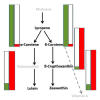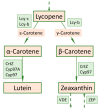Mutation Associated with Orange Fruit Color Increases Concentrations of β-Carotene in a Sweet Pepper Variety (Capsicum annuum L.)
- PMID: 34071303
- PMCID: PMC8227262
- DOI: 10.3390/foods10061225
Mutation Associated with Orange Fruit Color Increases Concentrations of β-Carotene in a Sweet Pepper Variety (Capsicum annuum L.)
Abstract
Pepper is the second most important vegetable crop in Bulgarian agriculture and has become the subject of extensive breeding programs that frequently employ induced mutagenesis. The success of breeding programs can be enhanced by the efficient and integral application of different biochemical and molecular methods to characterize specific mutant alleles. On the other hand, identifying new cost-effective methods is important under a limited-resources environment. In this paper we compare the levels of five health-related carotenoid compounds of fruits (α-carotene, β-carotene, lutein, β-cryptoxanthin, zeaxanthin) between a mutant variety Oranzheva kapia (possessing high ß-carotene concentration) and a corresponding initial pepper variety Pazardzhishka kapia 794. Both varieties are intended for fresh consumption. Pepper is a major natural source of β-carotene. It was observed that fruit at both commercial and botanical maturity from mutant variety had greater α-carotene and β-carotene concentrations to the initial variety (7.49 and 1.94 times higher, respectively) meaning that the mutant was superior in fruit quality to the initial genotype. Two hydroxylase enzymes, converting α- and β-carotene to lutein and zeaxanthin, respectively, are known to exist in pepper and are encoded by two genes on chromosomes 3 and 6-CrtZchr03 and CrtZchr06. The molecular characterization of the mutant variety through locus-specific Polymerase chain reaction amplification, gene cloning and sequencing as well as expression was performed. Our results suggest that the increased ß-carotene accumulation in the mutant variety Oranzheva kapia results from a biosynthetic pathway breakdown due to deletion of CrtZchr03 gene.
Keywords: carotenoids; high performance liquid chromatography; molecular characterization; mutagenesis; sweet pepper; β-carotene hydroxylase.
Conflict of interest statement
The authors declare no conflict of interest. The funders had no role in the design of the study; in the collection, analyses, or interpretation of data; in the writing of the manuscript, or in the decision to publish the results.
Figures







Similar articles
-
Mutation increasing β-carotene concentrations does not adversely affect concentrations of essential mineral elements in pepper fruit.PLoS One. 2017 Feb 16;12(2):e0172180. doi: 10.1371/journal.pone.0172180. eCollection 2017. PLoS One. 2017. PMID: 28207797 Free PMC article.
-
Induced mutation in β-CAROTENE HYDROXYLASE results in accumulation of β-carotene and conversion of red to orange color in pepper fruit.Theor Appl Genet. 2013 Mar;126(3):557-65. doi: 10.1007/s00122-012-2001-9. Epub 2012 Nov 3. Theor Appl Genet. 2013. PMID: 23124390
-
Effects of silencing key genes in the capsanthin biosynthetic pathway on fruit color of detached pepper fruits.BMC Plant Biol. 2014 Nov 18;14:314. doi: 10.1186/s12870-014-0314-3. BMC Plant Biol. 2014. PMID: 25403855 Free PMC article.
-
Biochemistry and molecular biology of carotenoid biosynthesis in chili peppers (Capsicum spp.).Int J Mol Sci. 2013 Sep 16;14(9):19025-53. doi: 10.3390/ijms140919025. Int J Mol Sci. 2013. PMID: 24065101 Free PMC article. Review.
-
Carotenoids of Capsicum Fruits: Pigment Profile and Health-Promoting Functional Attributes.Antioxidants (Basel). 2019 Oct 9;8(10):469. doi: 10.3390/antiox8100469. Antioxidants (Basel). 2019. PMID: 31600964 Free PMC article. Review.
Cited by
-
Integrated Metabolomic and Transcriptomic Analyses Reveal the Basis for Carotenoid Biosynthesis in Sweet Potato (Ipomoea batatas (L.) Lam.) Storage Roots.Metabolites. 2022 Oct 23;12(11):1010. doi: 10.3390/metabo12111010. Metabolites. 2022. PMID: 36355093 Free PMC article.
-
Development of an HPLC-PDA Method for the Determination of Capsanthin, Zeaxanthin, Lutein, β-Cryptoxanthin and β-Carotene Simultaneously in Chili Peppers and Products.Molecules. 2023 Mar 3;28(5):2362. doi: 10.3390/molecules28052362. Molecules. 2023. PMID: 36903607 Free PMC article.
-
Fast and High-Efficiency Synthesis of Capsanthin in Pepper by Transient Expression of Geminivirus.Int J Mol Sci. 2023 Oct 9;24(19):15008. doi: 10.3390/ijms241915008. Int J Mol Sci. 2023. PMID: 37834456 Free PMC article.
-
Analysis of changes in nutritional compounds of dried yellow chili after different processing treatments.Sci Rep. 2024 Sep 16;14(1):21639. doi: 10.1038/s41598-024-72464-2. Sci Rep. 2024. PMID: 39284844 Free PMC article.
-
Research on the mining of candidate genes for pepper fruit color and development of SNP markers based on SLAF-seq technology.Sci Rep. 2025 Apr 3;15(1):11392. doi: 10.1038/s41598-025-95552-3. Sci Rep. 2025. PMID: 40181030 Free PMC article.
References
-
- Hurtado-Hernandez H., Smith P.G. Inheritance of mature fruit color in Capsicum annuum L. . J. Hered. 1985;76:211–213. doi: 10.1093/oxfordjournals.jhered.a110070. - DOI
-
- Kraft K.H., Brown C.H., Nabhan G.P., Luedeling E., Ruiz J.D.J.L., D’Eeckenbrugge G.C., Hijmans R.J., Gepts P. Multiple lines of evidence for the origin of domesticated chili pepper, Capsicum annuum, in Mexico. Proc. Natl. Acad. Sci. USA. 2014;111:6165–6170. doi: 10.1073/pnas.1308933111. - DOI - PMC - PubMed
-
- Bharath S.M., Cilas C., Umaharan P. Fruit trait variation in a Caribbean germplasm collection of aromatic hot peppers (Capsicum chinense Jacq.) Hort. Sci. 2013;48:531–538. doi: 10.21273/HORTSCI.48.5.531. - DOI
-
- Tomlekova N.B. Induced mutagenesis for crop improvement in Bulgaria. [(accessed on 11 December 2020)];Plant Mutat. Rep. 2010 2:1–32. invited paper. ISSN: 1011-260X. Available online: http://www.iaea.org/inis/collection/NCLCollectionStore/_Public/42/080/42....
Grants and funding
LinkOut - more resources
Full Text Sources

